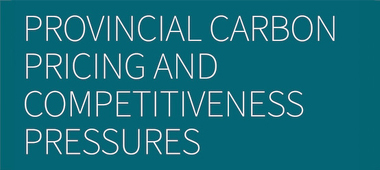What does carbon pricing mean for business competitiveness?
Competitiveness and leakage are important issues that can be addressed through careful policy design
- Competitiveness pressures for Canadian firms arise when carbon prices in Canada are significantly higher than carbon prices faced by those firms’ competitors in other jurisdictions.
- If unaddressed, these pressures can result in “leakage”—production or investment (as well as GHG emissions) shifting to other jurisdictions.
- Temporary, targeted, and transparent support to vulnerable sectors can address this problem while maintaining the effectiveness of carbon pricing.
Competitiveness pressures from carbon pricing affect a small part of the economy
- Canada’s Ecofiscal Commission estimates that at a carbon price of $30/tonne, around 5% of the Canadian economy is exposed to competitiveness pressures from carbon pricing. At $60/tonne, around 7% is exposed.
- Only sectors that are both emissions-intensive and trade-exposed (EITE) face competitiveness pressures.
- Emissions-intensive sectors have larger carbon costs as a share of the sector’s GDP
- Trade-exposed sectors sell their products in international markets and have competitors from countries that have lower or no effective carbon prices.
- EITE sectors in Canada include cement, lime and fertilizer manufacturing, refining, and oil and gas production.
- Provincial economies are very different from one another, so carbon competitiveness pressures differ across provinces; for example, in Alberta and Saskatchewan, around 18% of the economy is exposed, while in Ontario and Quebec it is 1 – 2%.
Business competitiveness is affected by several other factors
- Many factors—for example: corporate tax rates, wage rates, various regulations, exchange rates, prices for commodities and materials, exchange ranges—affect overall business competitiveness.
- Carbon pricing is one factor amongst many and, almost always, far from the largest factor.
Smart policy design can address competitiveness concerns
- “Output-based pricing” or “output-based allocations” (OBAs) (see here for an explainer) can be an effective policy to address competitiveness issues in EITE sectors.
- Under OBAs, firms pay the full carbon price only on emissions that exceed a given benchmark, paying nothing on the rest.
- Output-based pricing maintains incentives to reduce GHG emissions by improving performance, but protects competitiveness by removing incentives to shift production or investment (and the corresponding emissions) to other jurisdictions.
- OBAs are widely used in Canada—Alberta, Ontario, Quebec and the proposed federal carbon pricing system all apply OBAs to protect against competitiveness impacts and leakage.
- Other policies can also help address competitiveness concerns, most notably border carbon adjustments.
Other Resources
More Fast Facts on Carbon Pricing




